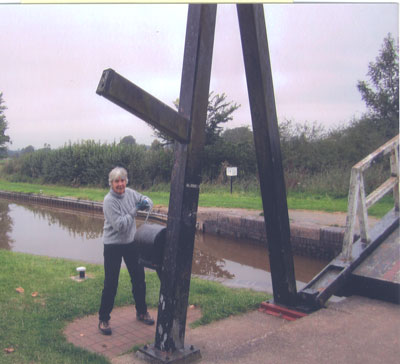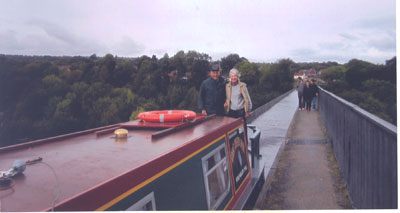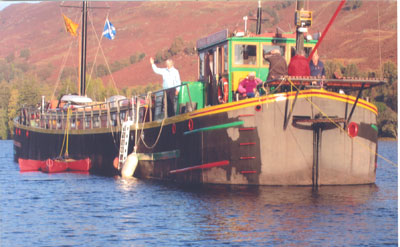Narrow boat, auto, barge in UK
Narrow boating is the ultimate do-it-yourself activity. You not only run the boat, cook and housekeep but operate the locks and raise the bridges on the canal or river. And “narrow” means just that, as the locks are as little as seven feet wide, which calls for a boat that is long and narrow, like a horizontal Ichabod Crane. My wife, Carol, and I have taken narrow boat vacations in England, Ireland, France and the US. On a trip in fall 2010 — when we were 77 and 80 — we visited three countries: Wales, piloting a narrow boat on the Llangollen Canal, considered among the most beautiful of canals; England, for a week’s car trip in the Lake District, and Scotland, aboard a barge on the Caledonian Canal.
For the Wales portion, on the Internet we found UK Boat Hire (PO Box 232, Worcester, WR1 2SD, U.K.; phone +44 1905 734168 or fax +44 1905 616715). They were very pleasant and helpful. We booked a 49-foot Grebe that contained two narrow berths along with the standard galley, lounge and a bathroom with a good shower, a toilet and a sink. Including fuel and a few incidentals, the cost of our rental, Sept. 26-Oct. 3, came to about £900 ($1,387), with a 2% handling fee charged to our debit card. For our days in the Lake District, we also needed to rent a car. We tried Europcar, but they wouldn’t accept our Morgan Stanley MasterCard debit card, so we went to Kemwel (Portland, ME; 800/678-0678), which booked us with Europcar, at a lower rate, using the same card — strange! Including the dropoff charge, the cost was less than $500 for 13 days, Sept. 26-Oct. 8. (Yes, the car would sit at the marina during our narrow boat cruise, but there was no other practical way to get from the airport to our starting point, to be able to pick up provisions, etc.) I am a Rotarian and belong to the International Travel & Hosting Fellowship, made up of club members who like to meet other Rotarians while traveling. Checking the directory, I located a member near the Lake District and e-mailed a request to be invited to stay overnight after our Welsh canal trip. The next day we received an enthusiastic reply along with detailed directions. I urge all Rotarians to consider this fellowship; it can enhance your travel experience, not only when visiting abroad but through hosting at home. We arrived in England at Manchester Airport — very “user friendly.” Our embarkation point was the marina at Wrenbury, England, 40 miles away. After we unloaded our luggage and provisions, an engineer came aboard the Great Crested Grebe to review with us the operation of the boat and its equipment. We headed off on the canal under his direction, but after just a few hundred yards we dropped him off and were on our own. I suspect our “tuition” was shorter than most because of our previous narrow boat experiences. We putted along at five miles per hour and came to our first lock. Carol worked the gates and paddles while I handled the boat. Yes, she did the heavy lifting, and this can be quite arduous, as sometimes the gates are quite heavy. She also had to crank up any bridges we encountered. (In France and Ireland, lockkeepers operate the locks for you.) We went through three locks before we tied up for the night and found a friendly pub for dinner. Our boat had a comfortable dinette set and a compact but complete kitchen. We usually had breakfast and lunch on board and dinner at a local pub. We had an adequate supply of gas to run the fridge and stove and enough diesel fuel for the boat for a week, but we had to replenish the water supply every day or so at “waterpoints” shown in our canal guidebook. The guidebook also showed locations of public toilets, shops, pubs, etc. We passed through 24 locks during the week. Because it was late September there were very few queues, but there can be long delays at the locks during the summer months.
The farmland scenery was beautiful. The gentle contour of the land soon gave way to a high aqueduct that carried the canal some 70 feet above the River Dee, which separates England from Wales, followed immediately by a 459-yard tunnel. Traffic on the aqueduct and through the tunnel is one-way, but, again, this was not a problem in late September. The crown jewel of British canals lay ahead. After another, shorter tunnel, we cruised the magnificent Pontcysyllte Aqueduct, over 1,000 feet long, taking us 127 feet above the River Dee. This brought us to Llangollen in northeast Wales, the end of the canal and the only site en route with a dockage fee (about £5). The next day we headed back, enjoying the sights in the other direction. In the chapter on the Lake District in the “Rick Steves’ England 2010” guide, he says to avoid the southern part of the district (he feels that it’s more touristy and less interesting), so we concentrated on driving in the northern part. We used his recommended farmhouse accommodations, restaurant suggestions and walking ideas as well. It worked for us.
Helen and David Oaxley and their three daughters made us very welcome at their B&B, Uzzicar Farm (Newlands Valley, Keswick; phone 01767 78026), where we paid about $100 per night. Our favorite lake was Buttermere, and our favorite restaurant was The Fish Inn (Cockermouth, Cumbria; phone 01767 70253), near Buttermere. The weather was amazing — rain-free and sunny throughout our visit! We turned in the car in Glasgow and the next day took a shuttle bus to the train for a more than four-hour trip through spectacular scenery to Fort William, the starting point of our Caledonia Canal cruise, Oct. 9-15. I booked this cruise, from Ft. William to Inverness, through the US agent TravLtips (Flushing, NY; 800/872-8584) for $2,219 for the two of us. As it turned out, they used unattractive currency-exchange rates — six or seven cents’ difference over what it would have been using my debit card. I believe I would have done better to contract directly through Fingal Cruising (Fort William, Scotland; phone +44 [0] 1397 772167). A taxi took us to Banvanie, where we boarded the Fingal of Caledonia, which can carry 12 passengers (our cruise had 10) and a crew of five. Built as a commercial vessel, it was remodeled to have six small bedrooms, each with an upper and lower berth and a well-appointed bathroom. In fact, the bathrooms seemed spacious compared to our cabin, and there was limitless hot water. We soon learned that getting dressed was a one-person-at-a-time operation in the small cabin. There was a lounge that could accommodate all passengers. Passengers and crew ate together at a huge, square dining table. Meals were hearty and served family style. The other passengers were three English couples and two single ladies (one English, one German). Of course, we were the oldest. Camaraderie developed quickly. The Caledonian Canal is about 60 miles long, connecting four lochs (Loch Ness, 30 miles long, is the largest section), with 22 miles of canals and 29 locks. We quickly fell into the Fingal routine. Every evening after dinner the captain would lay out a big map, reviewing where we had been as well as the next day’s activities. The options usually included hiking, canoeing, bicycling or just sitting on deck enjoying the scenery. The vessel carried five Old Town canoes and a fleet of top-notch bicycles as well as several windsurfers and a sailboat. We hiked and canoed most days, biked once and enjoyed each outing. The weather continued to smile on us — cool but not cold, with not a drop of rain. Too soon, we were moored in the outskirts of Inverness. The traditional haggis dinner signaled the end of our cruise, and we paid tribute to the crew for such a wonderful experience. Early the next morning, we took a taxi to catch our flight to Manchester. On our flight home, we realized we had experienced three completely different holidays in three very different locations: Wales, England and Scotland. A veritable British trifecta! TED MULLETT Vero Beach, FL



